Definitions
Asepsis
- The prevention of microbial contamination of living tissues or sterile materials
Disinfection
- The inactivation of non-sporing organisms using either thermal or chemical means
Sterilisation
- The complete destruction of all micro-organisms, including spores
Potential Difference
- The difference in electric potential between two points
Current
- The flow of electrons
Resistance
- The opposition to flow of an electric current
Impedence
- Impedence, designated by the letter Z, is defined as the sum of the forces that oppose electron movement in an AC circuit, incorporates resistance, inductance and capacitance
Inductance
- Inductance is the production of an electrical current when a conductor is in motion within a magnetic field
- Similarly, when an AC electrical current flows a magnetic field is generated
- A current flowing in a wire can therefore induce a current in an adjacent wire to which it is not physically connected.
Capacitance
- A capacitor is a system that consists of two electrical conductors separated by an insulator known as the dielectric
- Capacitance is the ability of a capacitor to store electrical charge
Capacitive Coupling
- Capacitive coupling is the transfer of alternating electrical signals or energy from one segment of a circuit to another via a capacitor
- It is one reason why a patient may become part of an electrical circuit. A patient lying on an operating table is a conductor, as is the operating lamp above the table. The air between the patient and the lamp is an insulator and acts as a dielectric in a capacitor. As the lamp is supplied by mains AC, a circuit may be set up between the lamp and the patient. Wires and cables in contact with the patient may also become part of the circuit and current may also flow in them in this situation.
Leakage Current
- The small current flow between the live circuitry and the case or accessible conductive component of an item of equipment
- It is present in all electrical equipment, as a result of capacitive coupling, induction between internal electrical components, or defective insulation
Macroshock
- A large amount of current passing through a person, that may lead to injury
Microshock
- Small amount of current that is delivered directly to the heart, that may cause ventricular fibrillation
Body Type Procedure
- Application of electrical connections from equipment that reduce or bypass the normal skin resistance
Cardiac Type Procedure
- Application of electrical connections within the chest, in contact with the heart, which are accessible outside the body
ANZCA Professional Documents
PS54 Minimum Safety Requirements Anaesthetic Machine
View ANZCA Professional Document PS54 in web browser
Electrical & Lasers
Electricity Basics
- Initially it seems a bit much that you need to know quite a bit about electricity for the exam - it is an anaesthetics exams, after all, not electrical engineering!
- However, given that we are primarily responsible for the safety of anaesthetised patient and once you know the potential electrical hazards in the operating theatre, it makes sense that we should understand a little about it
- Because there are so many layers of risk reduction strategies in place, an actual electrocution in theatres would be rare, so it is easy to get complacent and think that electrical safety is not important
- I don't pretend that I have a deep understanding of many of the concept presented here, but I think this depth of knowledge is enough for exam purposes
Electricity Supply
- Electricity in Australia is supplied at the power point as 240V AC 50Hz
- Why AC and not DC?
- The way that electricity generators work (rotating conducting wires around a magnet) naturally generates alternating current - you can revise your high school physics on inductance :p
- Why 50Hz?
- The lower the frequency, the more efficient the delivery of electricity - less energy is lost from the system
- Apparently 50Hz is the lowest frequency where flickering of lightbulbs is not noticeable, so this was chosen as the standard
- Why do I care about this for the exam?
- AC 50Hz is the most dangerous type of electrical current, in terms of causing ventricular fibrillation!
- AC is more effective than DC at provoking an electrical response in the heart (which is why biphasic defibrillators are more effective than monophasic defibrillators)
- 50Hz is the optimal frequency for eliciting an electrical response from the heart, potentially causing R on T and VF (higher frequencies, such as used in diathermy, change current direction too quickly for the heart to respond)
- Power stations output electricity at very high voltages (500kilovolts) which is distributed over long distances to power substations
- Substations use a step down transformer to reduce the voltage to 240V which is distributed to locally
- This step down process is employed because delivering electricity at high voltages over long distances is more energy efficient than low voltages
Step Down Transformers
- A step down transformer is basically two coils of wire sitting adjacent to each other
- An alternating current passing through the primary coil will induce a changing magnetic field which, in turn, will induce an alternating current in the secondary coil (again, you can revise your high school physics!)
- If the primary coil has twice as many turns as the secondary coil, then the voltage produced in the secondary coil is half that in the primary coil
- While I doubt this knowledge would be tested directly in the exam, you need to be familiar with transformers to understand the concept of line isolation monitors and floating circuits later on
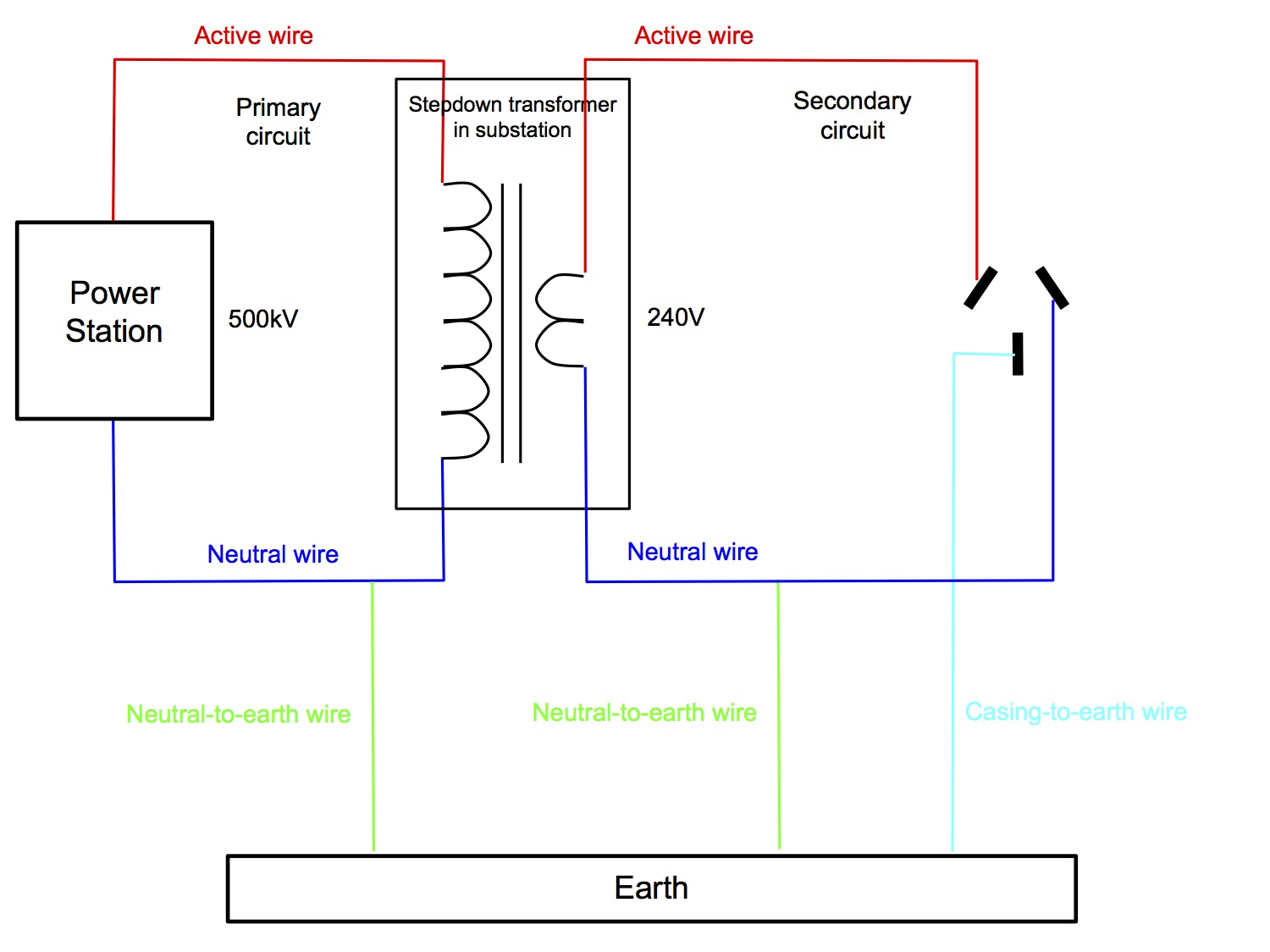
Power Point
- The top left pin connects to the active wire
- The top right pin connects to the neutral wire
- The bottom pin connects to the earth. For Class 1 equipment, this earths the case of the equipment
AC Circuit Terminology
- I found AC circuits much harder to understand than DC circuits
- DC circuits are straightforward - there is a negative wire connected to the negative pole of the battery and a positive wire connected to the positive pole of the battery, electrons flow around the circuit from the negative pole to the positive pole
- Because the current direction in AC circuits alternates with time, it's easy to get confused with all the jargon, particularly active vs neutral wire and the 2 types of earthing wires
- This is my understanding, I don't know if it's 100% accurate, but I think it's good enough for exam purposes
Active vs Neutral Wire
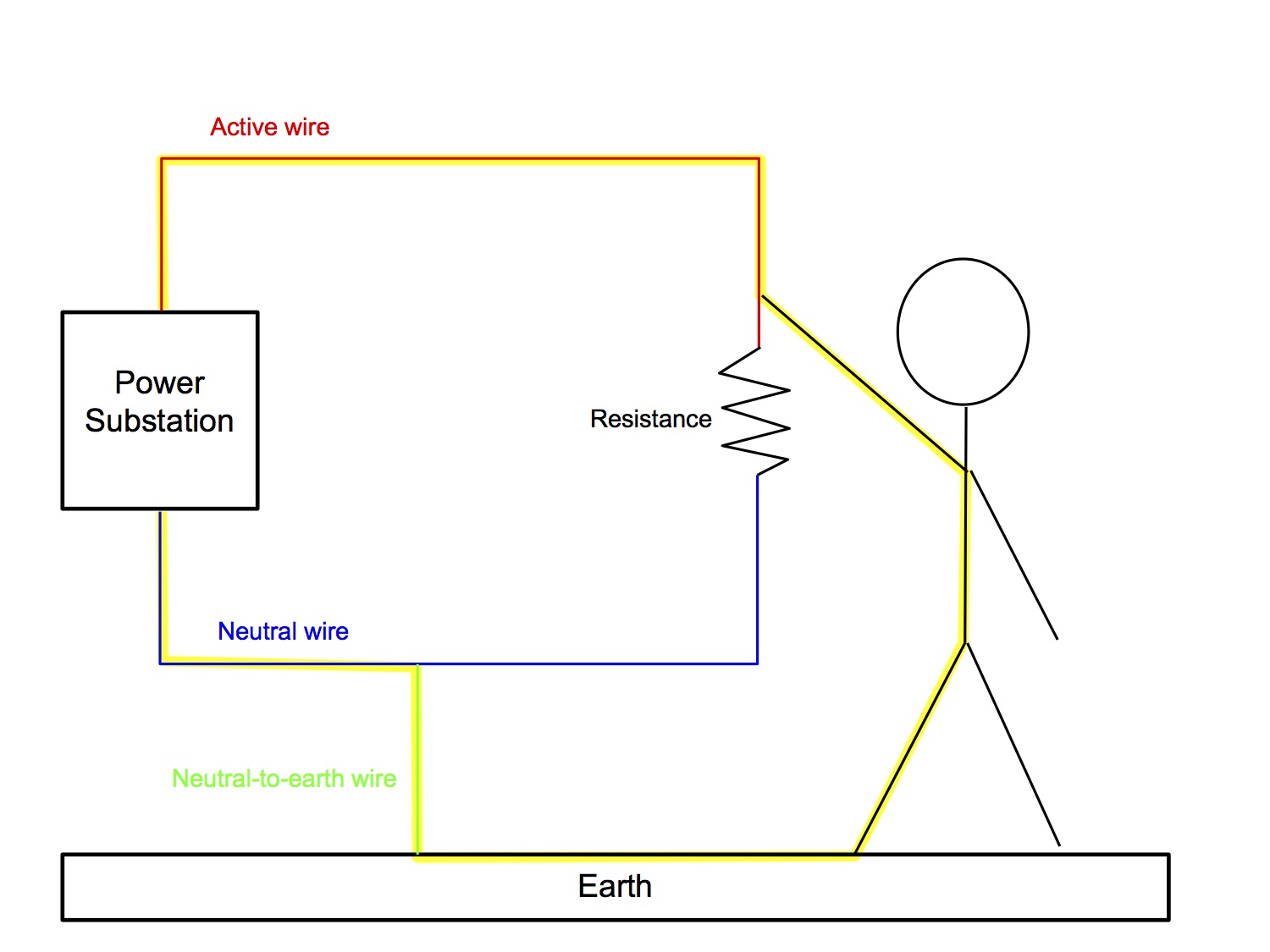
- Both wires carry current and are "live", so why is one called active, and the other neutral?
- The difference is that the neutral wire has a wire that connects it to earth (the neutral-to-earth wire)
- If there is a fault and you somehow touch the active wire, depending on the relative resistance of the normal circuit pathway vs going through you to earth, you may be electrocuted
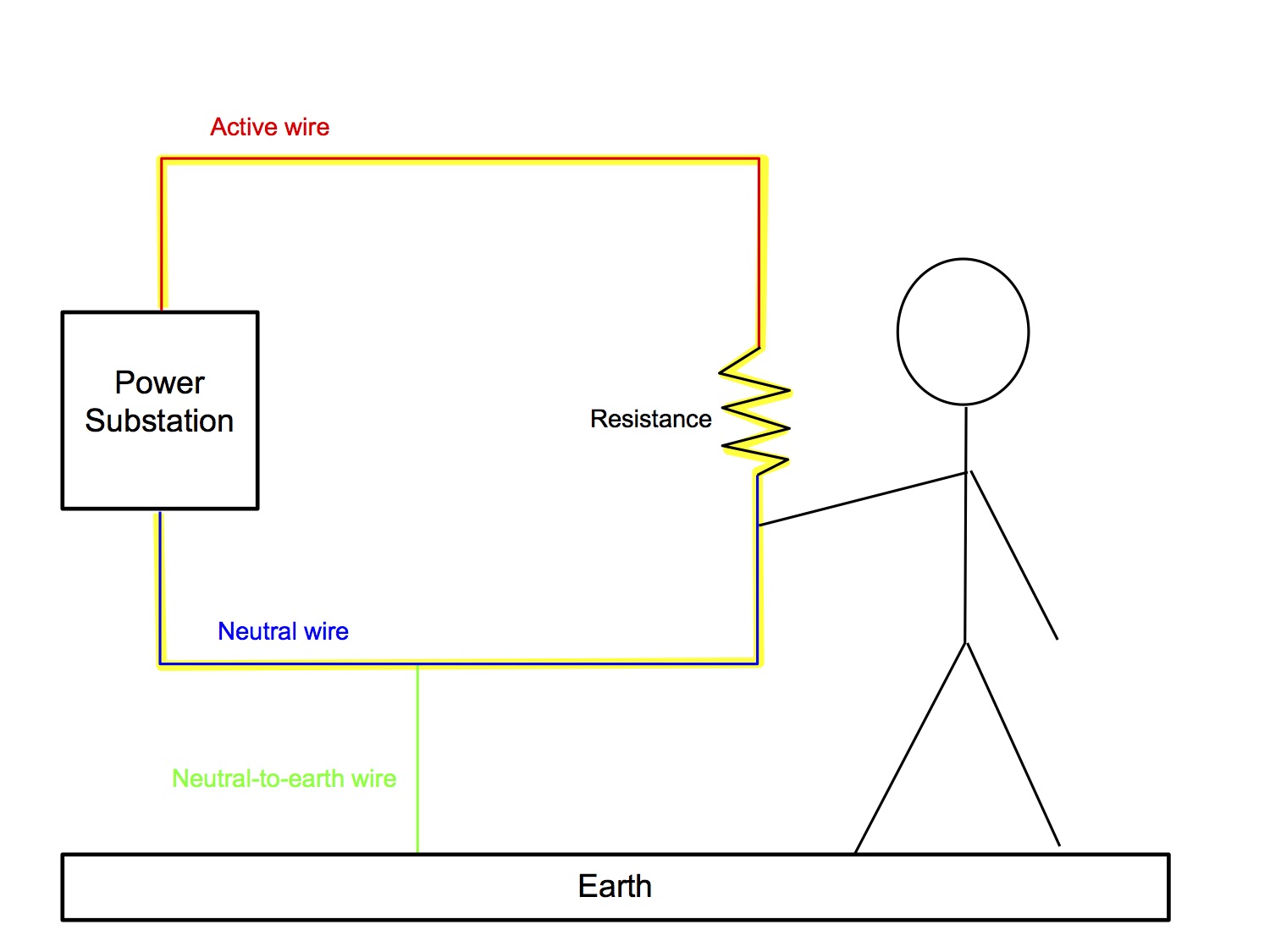
- If there is a fault and you somehow touch the neutral wire, you will not be electrocuted because the normal circuit pathway will be much lower resistance than going through you to earth
- Another reason why I think the neutral wire is called "neutral", is because of the way that the electrical grid is set up: 3-phase electric power supply
- Electricity to a particular area is supplied via 3 active wires, where the alternating current is set to be 1/3 of a cycle out of phase with one another
- The electric circuit for all 3 active wires is completed back to the power station by one single neutral wire
- When the currents in all 3 active wires are combined, they cancel each other out (like a noise-cancelling headphone) so no current flows in the neutral wire and it truly is neutral
- Apparently this makes the system more energy efficient
- This is why you see 4 power lines together - 3 active, 1 neutral
Earthing Wires
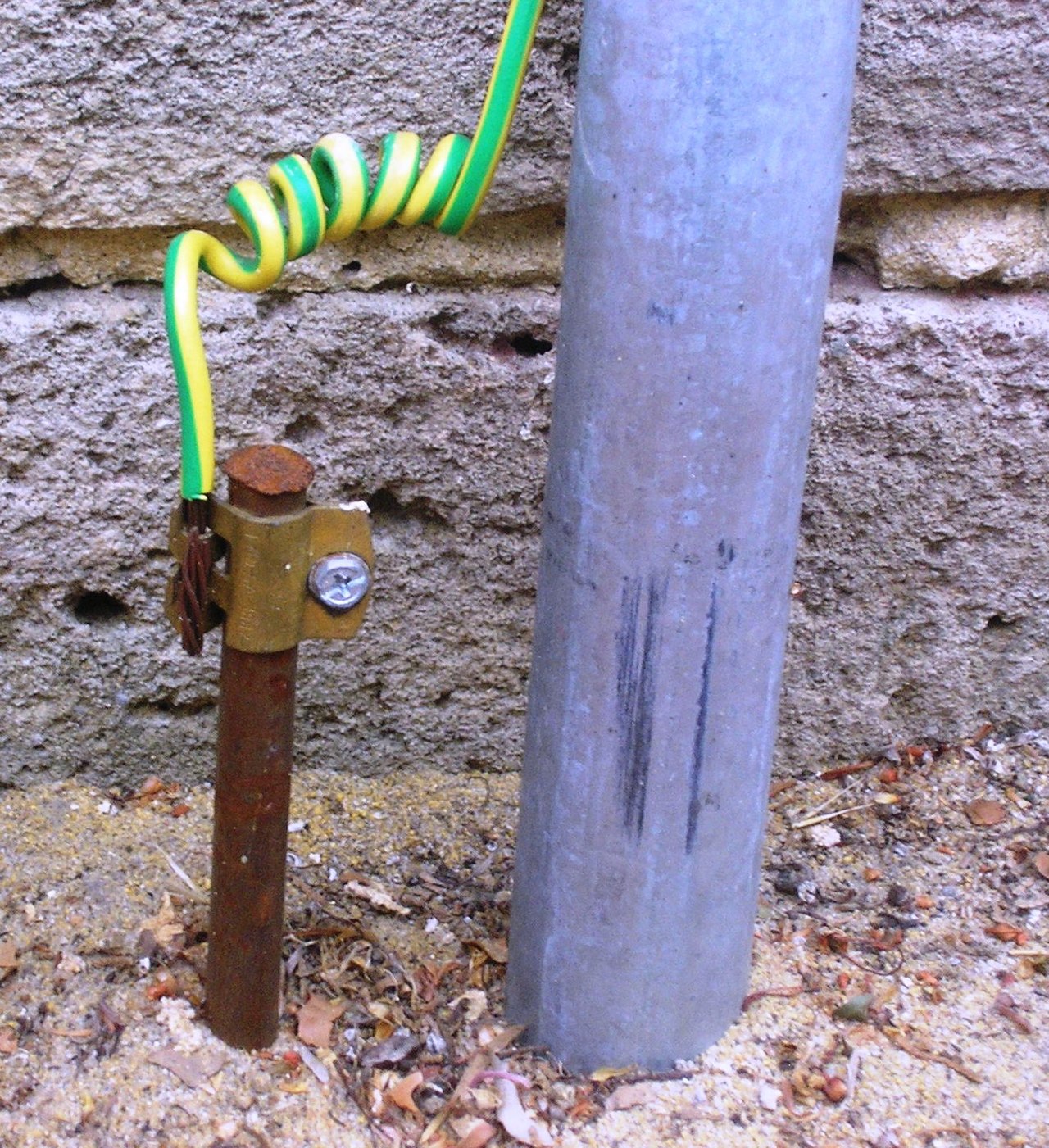
- A potential source of confusion is that there are two types of wires that can be called earth or ground wires, because they create a low resistance electrical connection to earth (usually a low resistance conductive rod that is buried into the ground)
Neutral-to-Earth Wire
- This wire connects the neutral wire to earth
- If there is a fault and you contact the active wire, you can be electrocuted because the neutral-to-earth wire can complete the circuit
- If there were no neutral-to-earth-wire, you could not be electrocuted. So what is its purpose?
- The neutral-to-earth wire is there to protect residences from lightning strike
- Power lines are exposed to the elements and prone to being struck by lightning
- The neutral-to-earth wire provides a pathway for the electrical discharge to be safely dispersed into the ground
- If it were not present, the large amount of electrical energy would be transmitted into residences
- In reality, the neutral wire is grounded at multiple points between the power station, substation and residence (multiple earth neutral MEN system)

Casing-to-Earth Wire (Class 1 Equipment)
- Class 1 equipment has a wire that is attached to its outer metal casing to the bottom pin of the power point which is connected to earth
- If there is a fault whereby the active wire contacts the casing, and the casing becomes "live", then the casing-to-earth wire provides a low resistance pathway down to earth
- This will prevent someone who touches the live casing from being electrocuted
- See later section on Equipment Classes
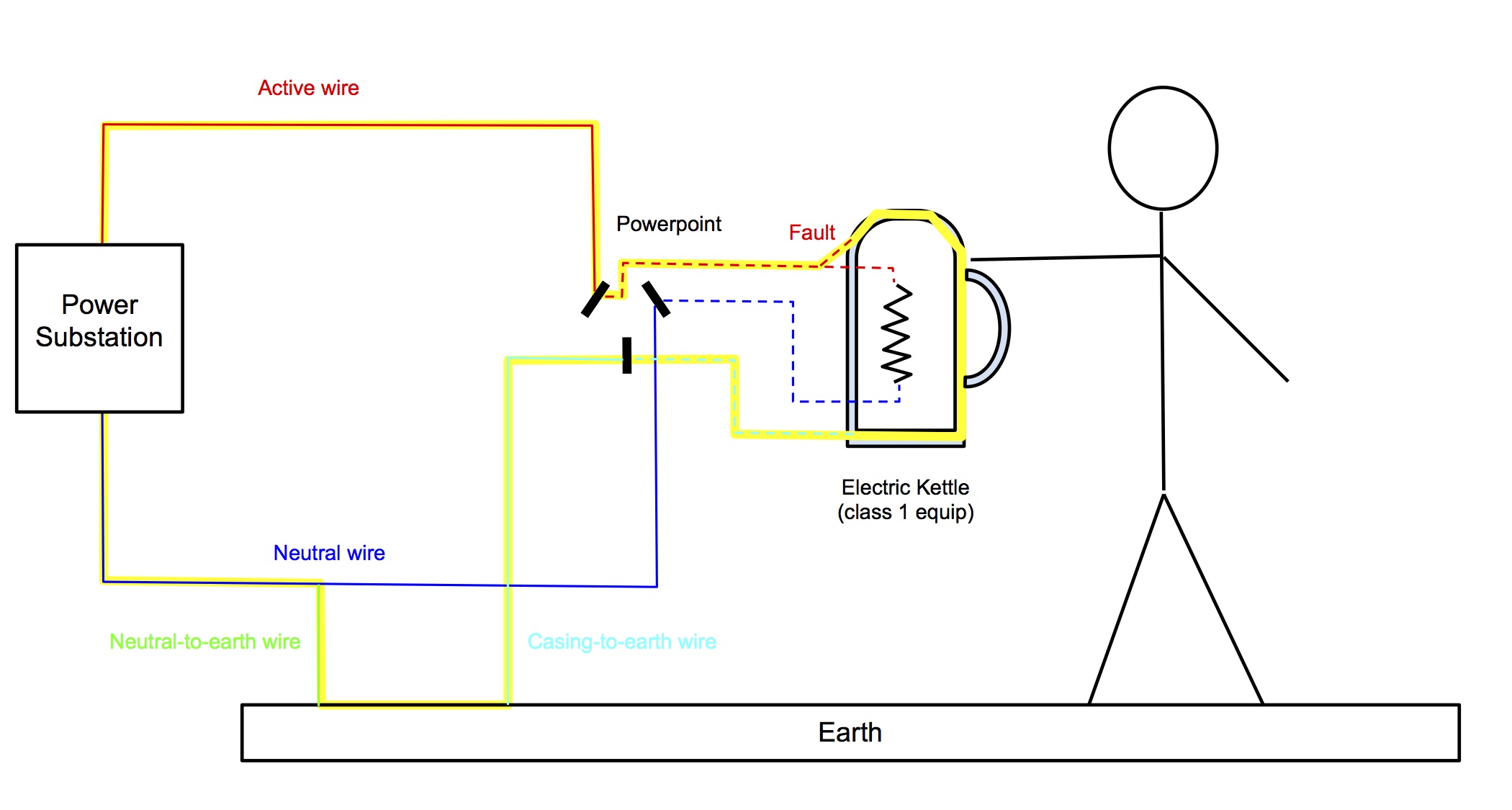
Macroshock
- A large amount of current passing through a person, that may lead to injury
| Current | Consequence |
|---|---|
| 1mA | The threshold of perception |
| 5mA | Accepted as maximum harmless current |
| 10mA | The “ let go” current above which sustained muscle contraction occurs |
| 50mA | The threshold of pain |
| 100mA | VF if current passes through heart |
| 6000mA | Burns if current density high |
Microshock
- Small amount of current that is delivered directly to the heart, that may cause ventricular fibrillation
- If there is a direct electrical connection to the heart, eg saline filled CVC with tip within 6cm of heart or pacing wires, a small, otherwise imperceptible current as low as 100uA (0.1mA) can cause VF
- This is because, even though there may be only a small current, there is a high current density in the heart
Electrical Safety in the Operating Theatre
- For a person to receive a shock, there must be 2 conditions met:
- There is a source of potential difference
- The person becomes part of a low resistance, complete electrical circuit connected to the source
- Sources of potential difference may include
- A fault that exposes a direct or indirect connection to the active wire
- Leakage current from equipment
- Operating theatres is an environment prone to electrical risk because
- There are many items of equipment in use that are potential sources of electrical fault or leakage current
- We often do things that reduce skin electrical resistance (application of ECG dot gel, intravascular cannulation, spillage of fluids), which not only increases the risk of macroshock, but also introduces the risk of microshock
- An anaesthetised patient cannot move away if an electric shock is felt
- The risk is reduced by requiring special safety criteria for
- Electrical supply design of the OR (residual current devices, line isolation monitors, equipotential earthing)
- Biomedical equipment design
Residual Current Device (RCD)
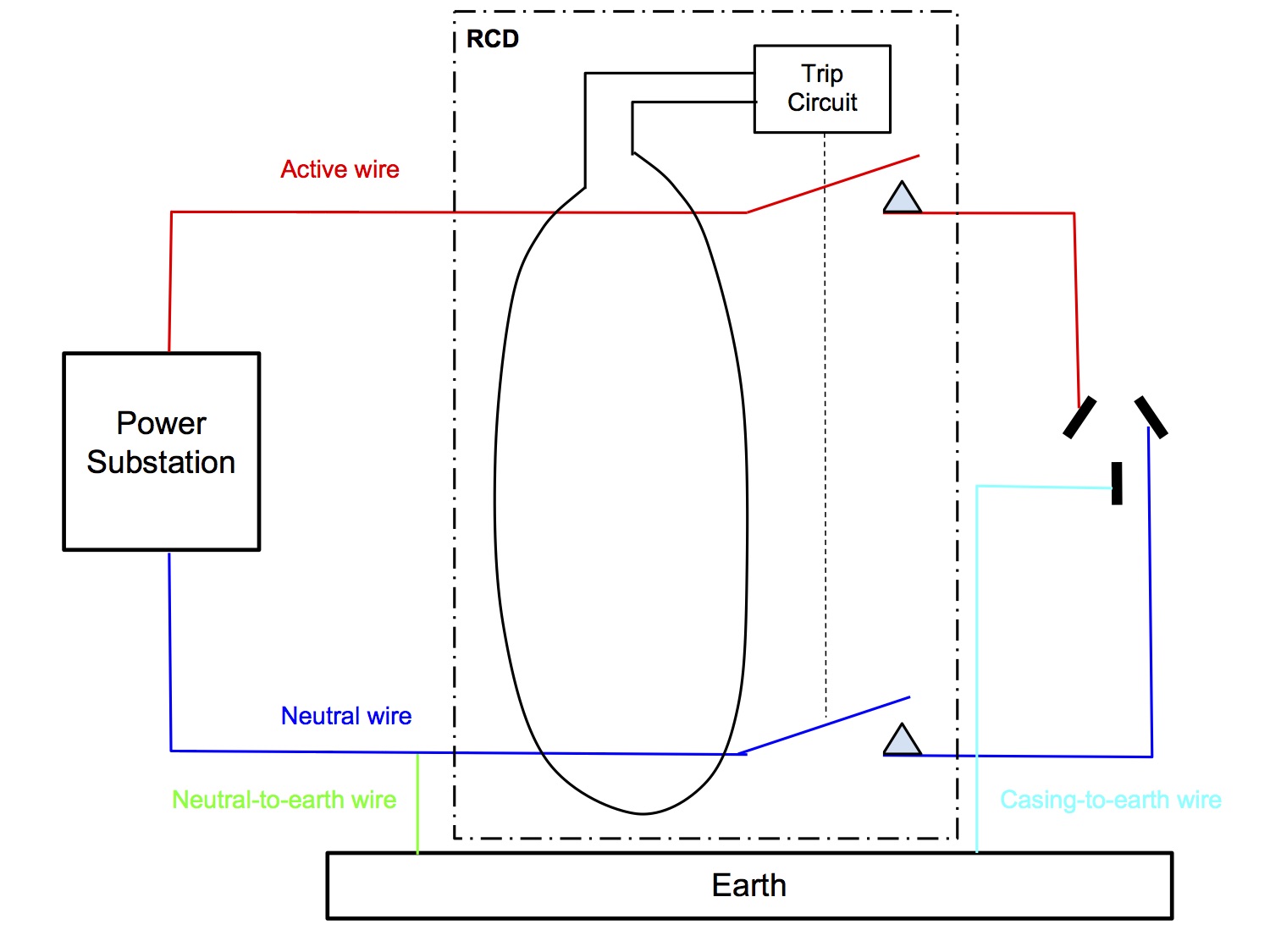
- Also known as an Earth Leakage Core - Balance Device
- In an RCD, the active and neutral wires pass through a toroidal detector coil (a donut shaped coil of wire)
- The changing magnetic fields generated by AC current passing through the active and neutral wires will induce currents in the detector coil
- If the current flow through the active and neutral wires is equal (ie no leakage to earth), the induced currents will be equal and opposite resulting in no net flow in the detector coil
- If a fault results in current leaking to earth, then the flow in the active and neutral wires will be different and a current will be induced in the detector coil, this will then trip the circuit breakers and interrupt the power supply
- A detected current leakage of 5-10mA will interrupt the power supply within 40ms
- At my hospital, power points that are protected by an RCD are red
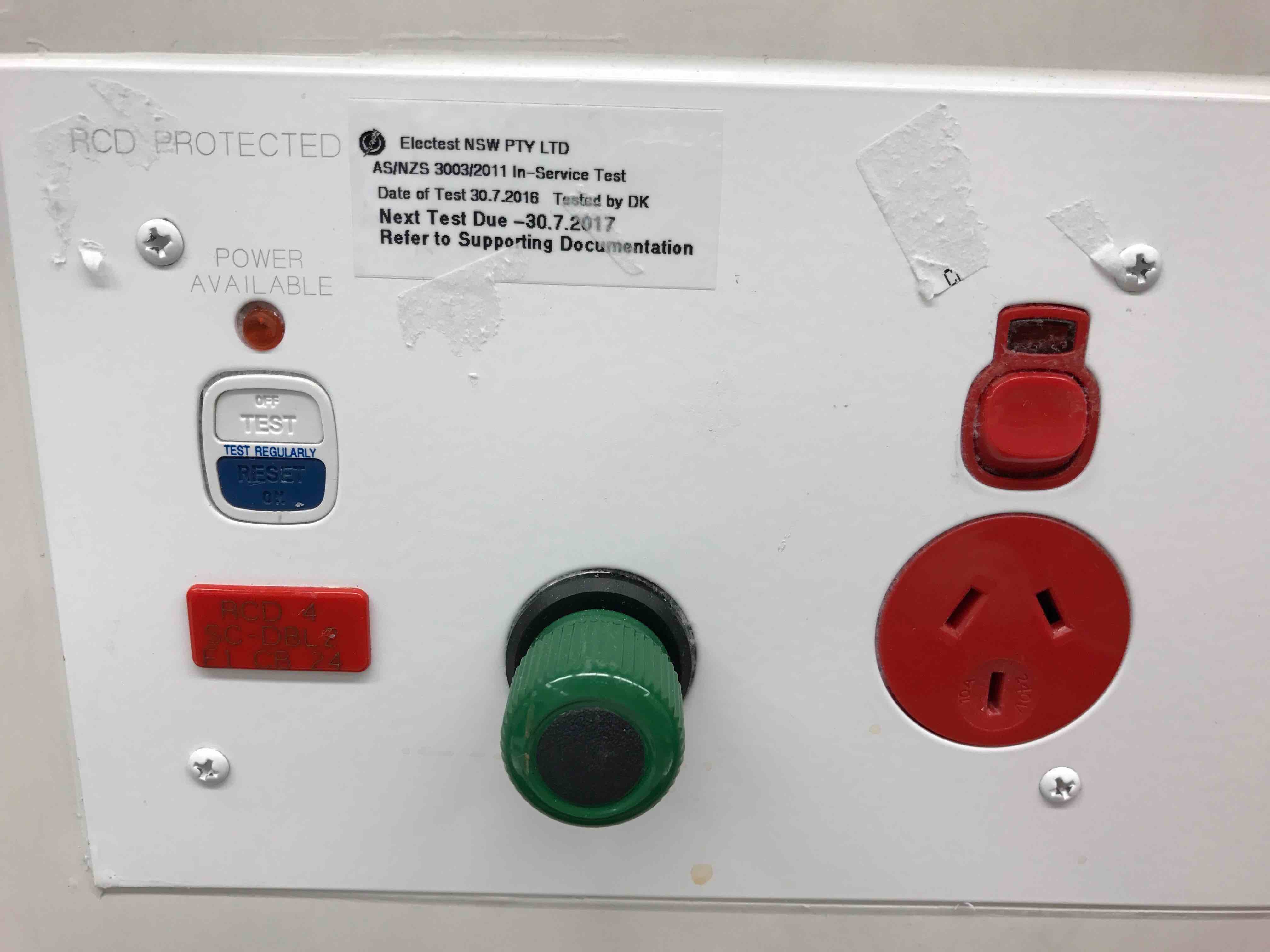
Line Isolation & Overload Monitor (LIM)
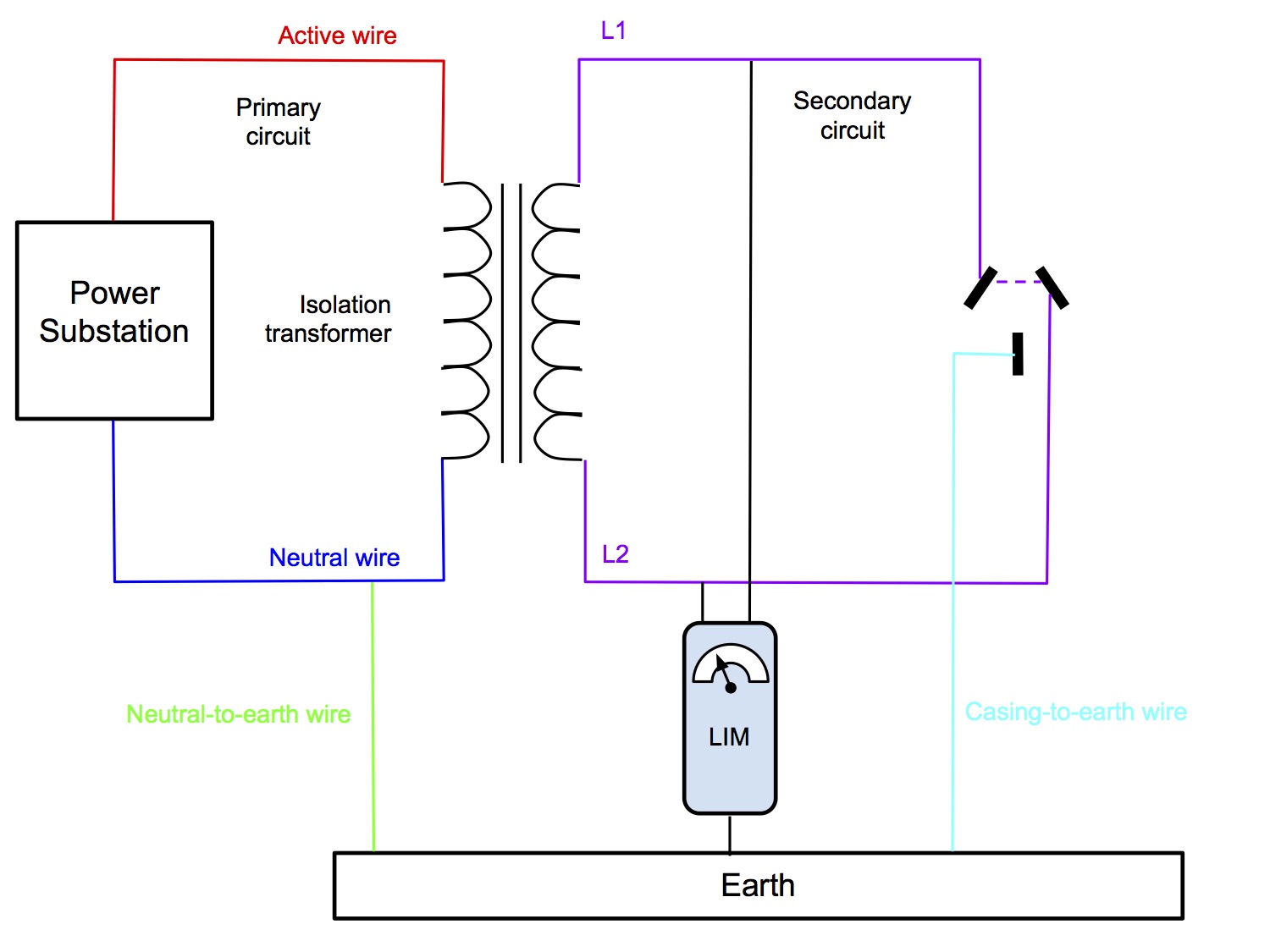
- This system uses an isolation transformer used to create floating circuit that is isolated from earth
- An isolation transformer is a transformer in which the primary and secondary coils have the same number of turns, which means the voltage in the secondary circuit is the same as in the primary circuit. What is the point then?
- The advantage of this is that the secondary circuit is floating or ungrounded. This means that touching an active wire will not result in a shock because there is no connection from earth back up to the secondary circuit to form a complete circuit
- Because neither wire is earthed, they cannot be labelled active or neutral and are simply referred to as line 1 and line 2
- For a shock to occur, there must also be a second fault where a connection from the secondary circuit to earth is formed
- LIM detects when isolation from earth is breached, by injecting a small test current and comparing the resistance to earth in lines 1 and 2 (I don't really get that part myself, to be honest!)
- The LIM will alarm if the prospective hazard current > 5mA
- The difference between an RCD and a LIM is that an RCD will interrupt the power supply if a leak is detected, while a LIM will alarm but will not interrupt the supply
- This is so that power to critical life support equipment is not shut off. I think pretty much all the equipment we use nowadays has an inbuilt backup battery so this seems less critical now...
- If the LIM alarms, you should unplug the last item of equipment that was plugged in as this is the most likely source of the fault
- Power points protected by a LIM are blue at my hospital
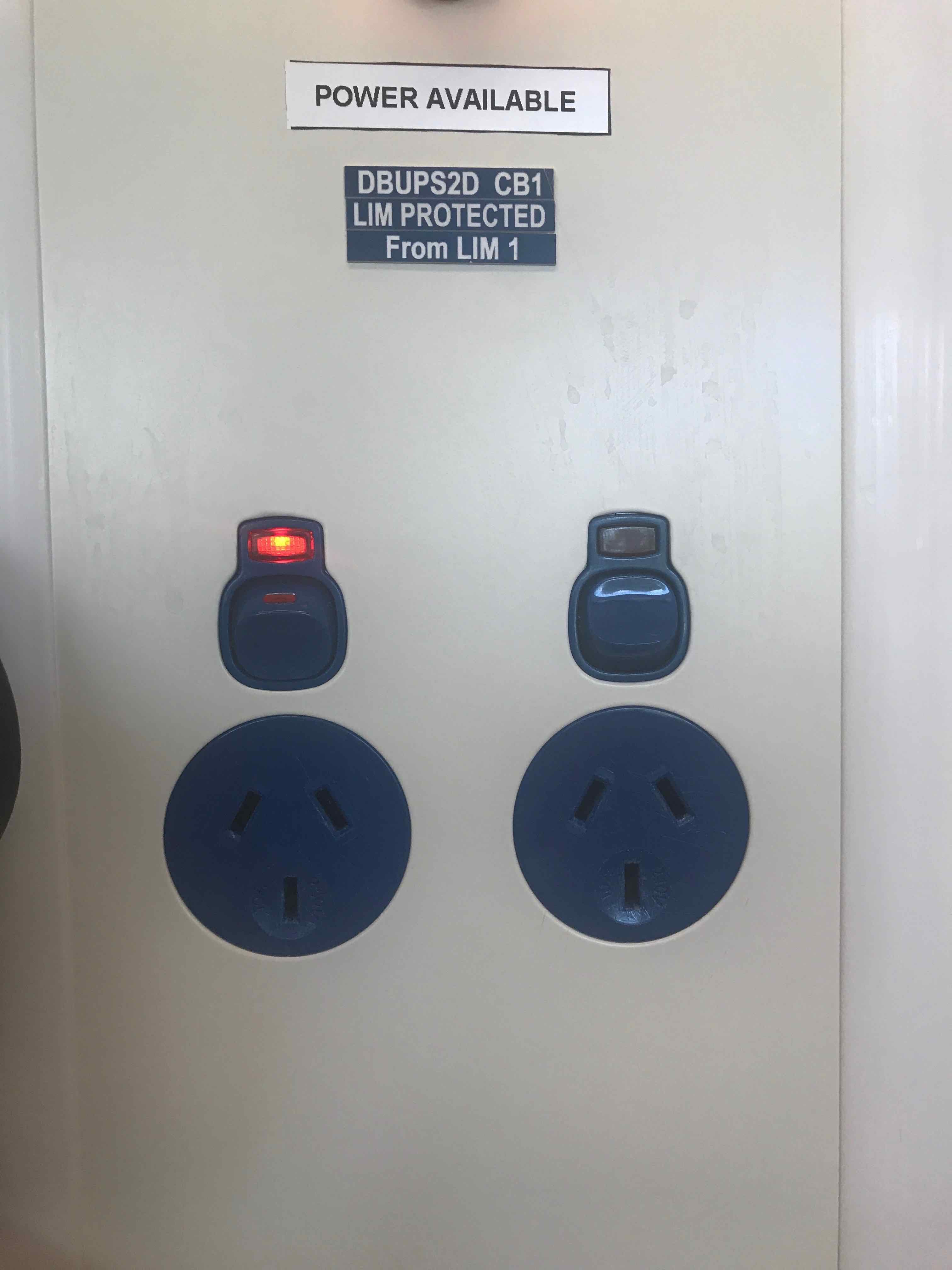
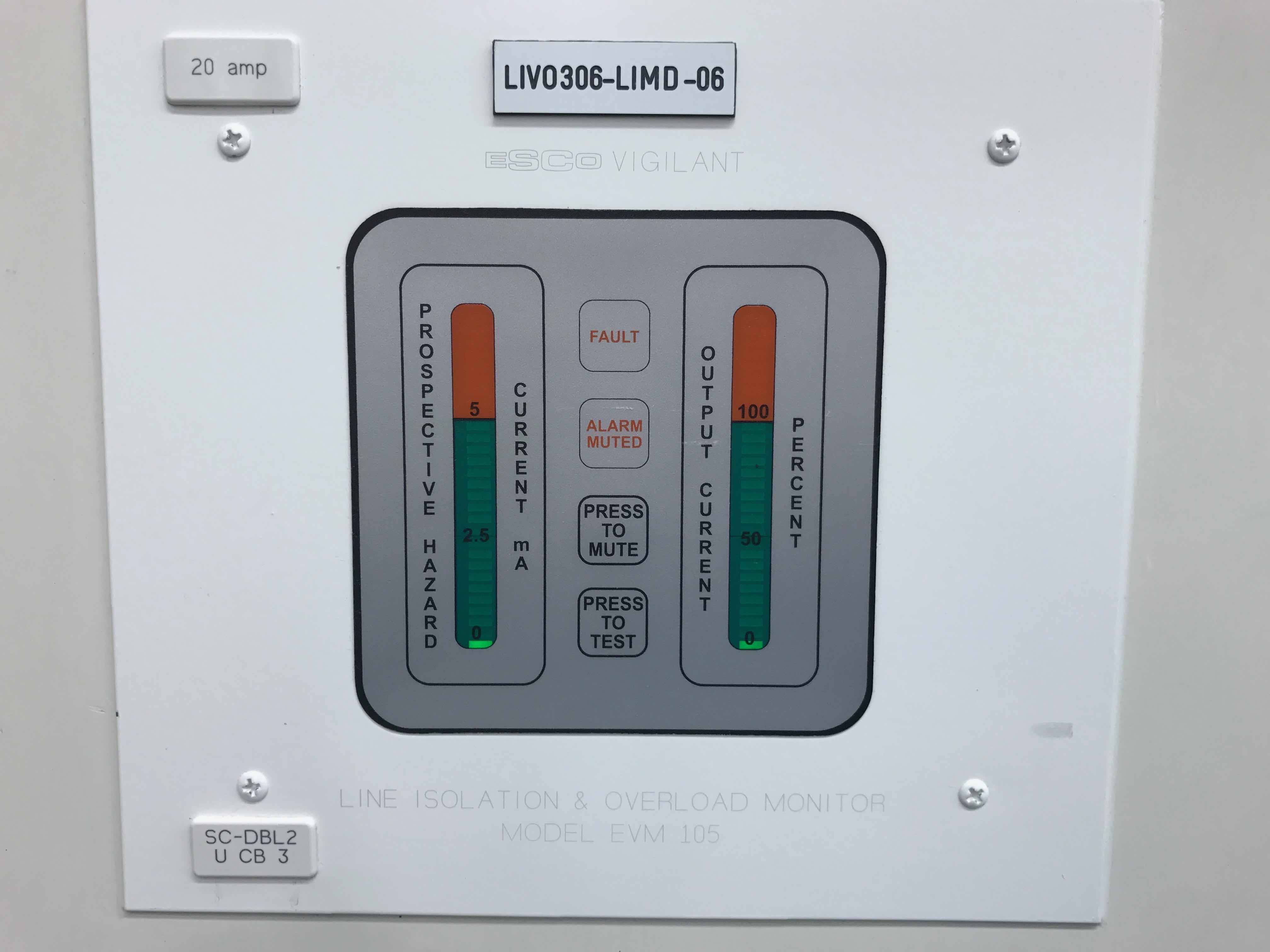
Equipotential Earthing System (EES)
- Normally Earth wires at different power points have a small potential difference between them due to the sum of resistances in the wires and connections between the power point and power supply
- EES uses a large diameter copper cable to connect all earth points in a room together to minimise the resistance between them and equalise the potential at all earth points
- This reduces the potential sources of a microshock, which is why an EES is a requirement for a cardiac protected treatment area
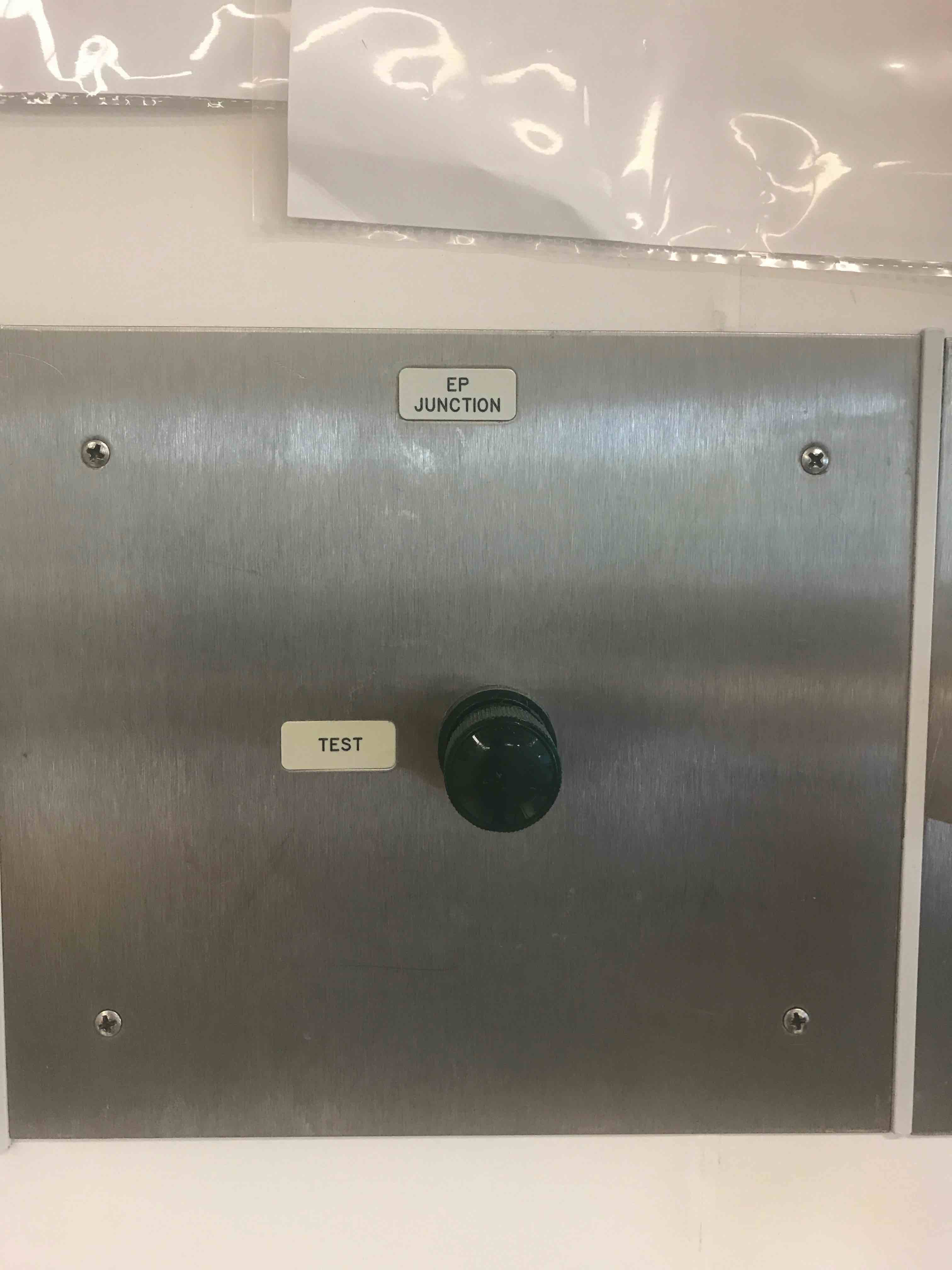
Equipment Classes
- Class I
- Equipment that has an earth wire connected to its outer metal casing
- This protects against shock in case a fault causes the active wire to contact the outer case
- eg refrigerator, electric kettle
- Class II
- Double insulated equipment
- Has a plastic outer case in addition to the normal internal insulation
- An earth wire is not required as the outer casing is non-conductive
- eg hair dryer
- Class III
- Extralow voltage (< 40V) or battery powered equipment
- Doesn't require an earth wire, even if it has a metal case because the voltage is low so that the risk of macroshock is negligible eg mobile phone
Applied Parts
- Applied parts are the electrical connections made to a patient by biomedical equipment
- There are 3 levels of shock protection ranked according to the maximum allowable leakage current in the event of a fault
- Type B (Unprotected)
- Current flow between equipment and patient is only limited by the patient's impedence
- Max allowable current is 500uA if used with Class I or 100uA if used with Class II
- Some patient equipment cannot be constructed with floating applied part
- Symbol - man
- Type BF (Body Protected, Floating)
- Current flow is limited in the event of a fault
- Same leakage current standards as B, but incorporates an isolation transformer, to prevent macroshock
- eg automated NIBP cuff
- Symbol - man in a box
- Type CF (Cardiac Protected, Floating)
- Current flow is limited to prevent microshock
- Max allowable leakage current 50uA (if Class I) or 10uA if Class II
- Is the only equipment type safe for direct cardiac contact
- eg invasive pressure monitor
- Symbol - heart in a box
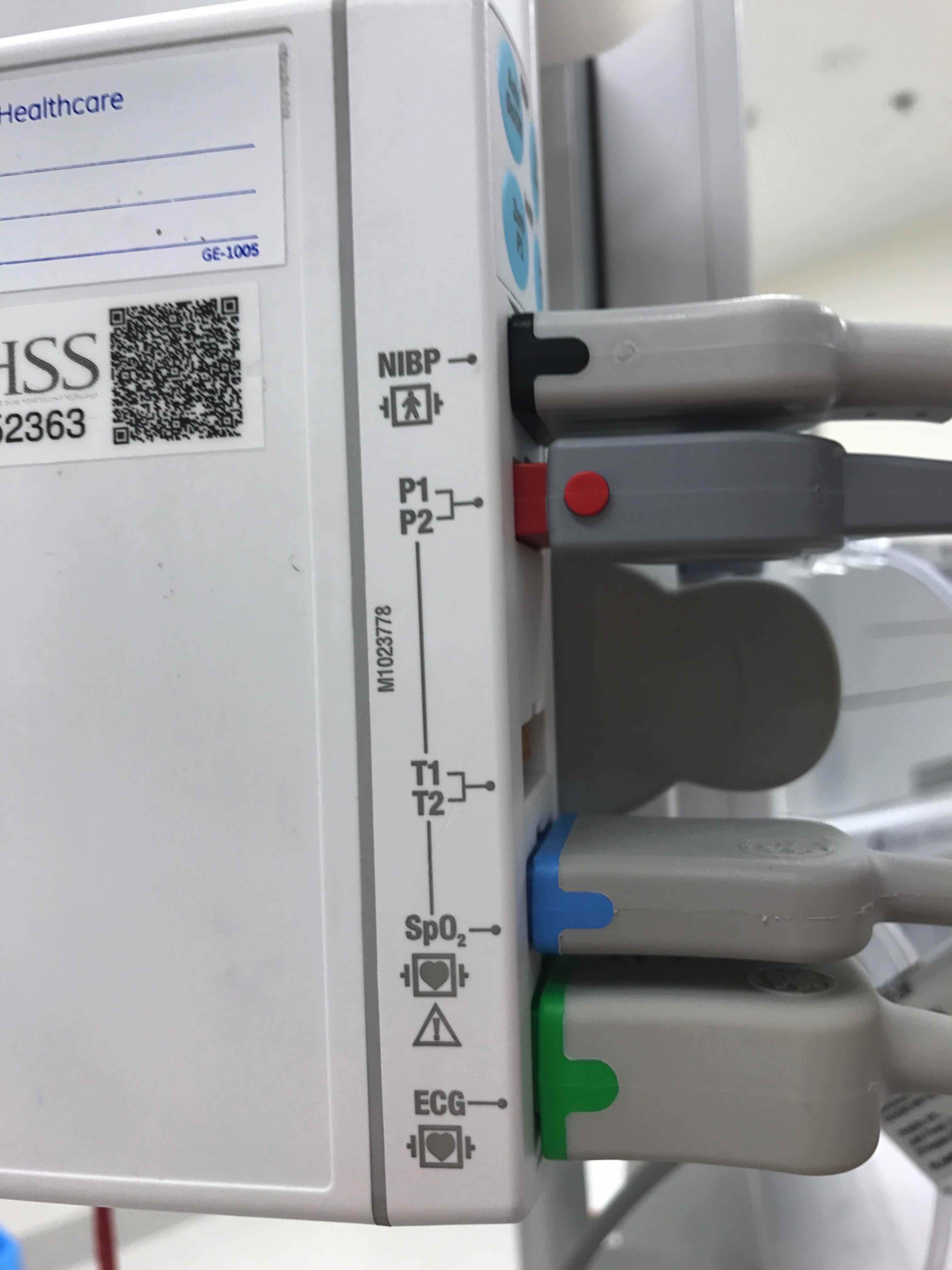
Procedure Types & Treatment Areas
Procedure Types
Body Type Procedure
- Application of electrical connections from equipment that reduce or bypass the normal skin resistance
- Eg ECG electrode gel, iv lines
- Removal of protective skin resistance increases risk of macroshock
Cardiac Type Procedure
- Application of electrical connections within the chest, in contact with the heart, which are accessible outside the body
- Eg pacing wires, saline filled CVC with tip within 6cm of heart
- Minute currents may induce microshock
Treatment Areas
Body Protected Treatment Area
- Required where equipment is attached to patient with no direct cardiac connections (body type procedures)
- Requires RCD or LIOM
- Offers protection from macroshock
Cardiac Protected Treatment Area
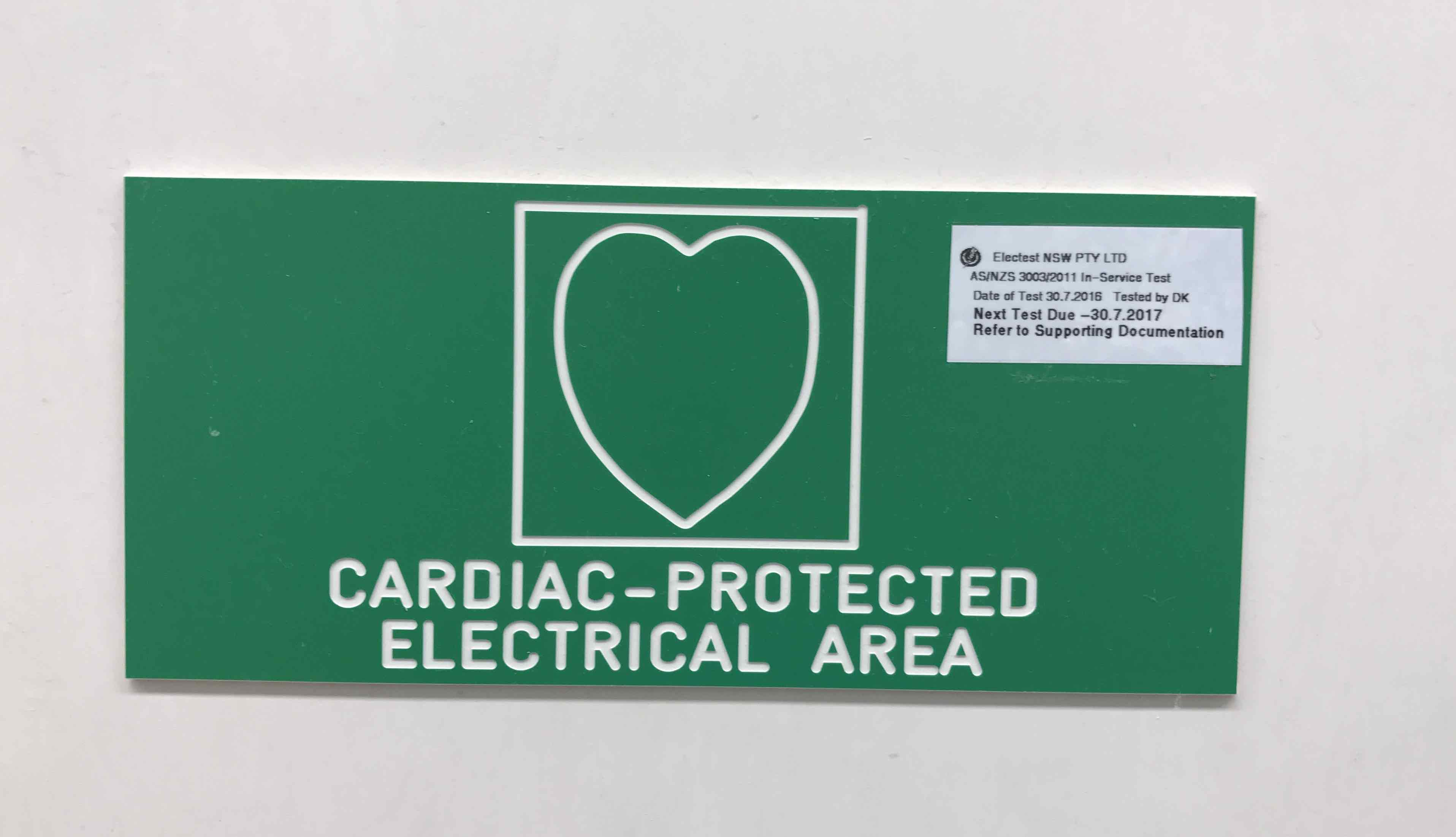
- Required where direct cardiac connection is likely (cardiac type procedures)
- Requires LIOM or RCD
- In addition, also requires equipotential earthing system
- Protects against microshock
- NB This means you shouldn't be putting in PICCs on the ward, unless it's in a cardiac protected Treatment Room!
What type of area is Operating Theatres?
- Operating Theatres are cardiac protected treatment areas
- The next time you are in the OT, look around your theatre and identify the RCD outlets, LIOM and EP testing junctions (see next section). I bet like me, you never paid attention to them before!
Diathermy
- Uses AC current, at 300kHz to 2MHz, to heat tissue, allowing cutting of tissue and coagulation of blood
- Heat generated is proportional to power (square of current x resistance)
- High current density at tip of instrument, reaches temps of 1000C
Unipolar
- Requires placement of a diathermy plate (dispersive electrode, "ground plate", "return plate")
- The electrical circuit passes from the diathermy probe, through the patient and to the return plate
- The large surface area of the return plate reduces the current density and prevents burns at the contact area
- NB "return plate" is a misnomer as the current is AC, so the current flows both ways
- Cut mode: high current, continuous sine wave, low voltage (250V)
- Coag mode: High voltage (9000V), interrupted damped sine wave
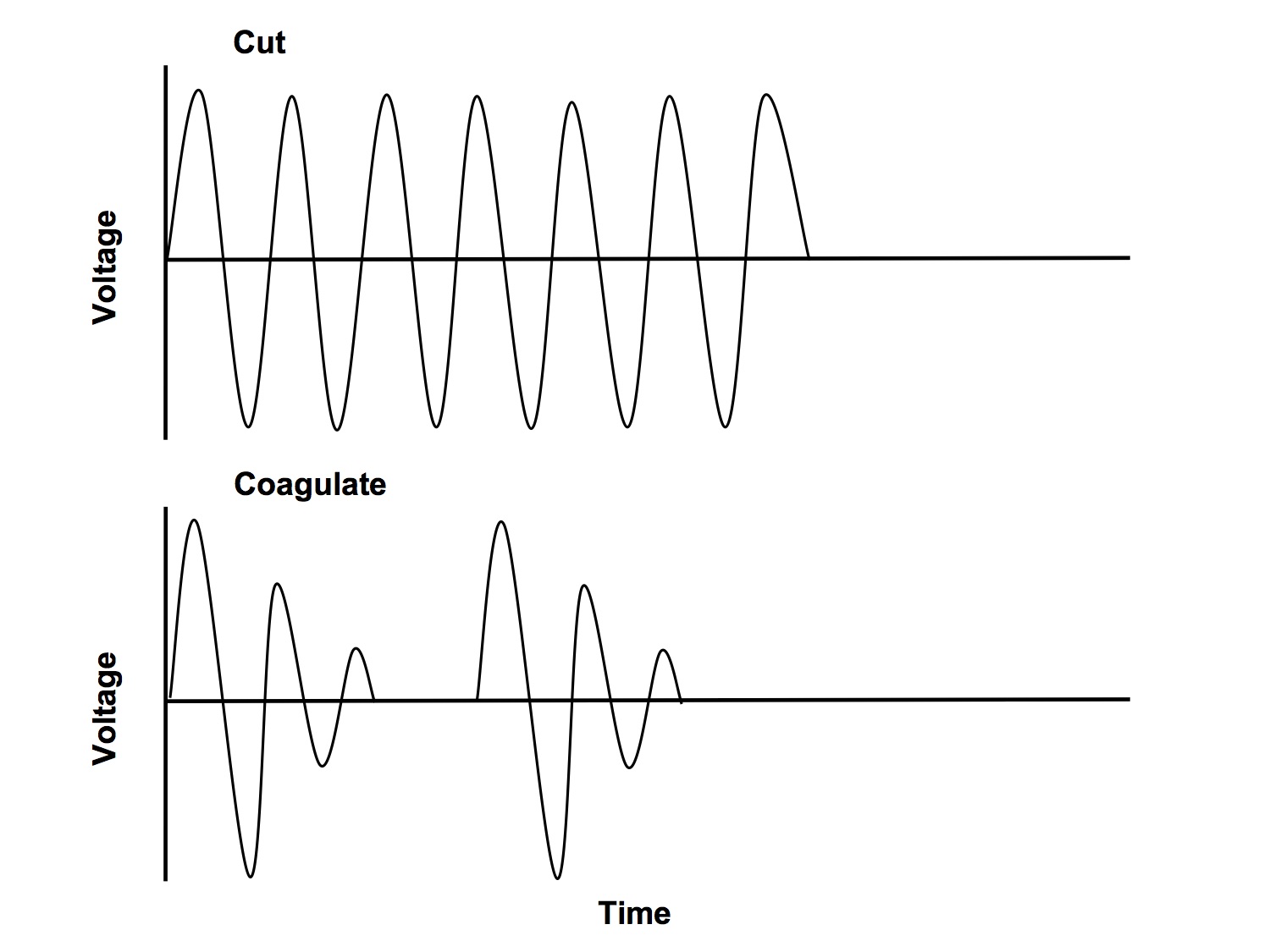
Bipolar
- The electrical current passes between the two prongs of the diathermy forceps
- Only the small amount of tissue between the forceps is exposed to the current, thus improving safety
- However, the bipolar instrument is most suitable for use to control spot bleeding and is not very suitable for surgical cutting, therefore unipolar diathermy has a wider application
Hazards & Safety
- Burns to patient
- Return plate must be properly adhered to the pt, otherwise may cause high current density or current may return via alternate pathways. Plate should:
- Hold enough conductive gel
- Firmly adhered
- Avoid proximity to bony prominences and metal prostheses, ECG electrodes
- Below thorax if PPM
- Fire hazard
- If flammable prep is used
- Pacemakers
- May interpret diathermy as intrinsic activity and stop pacing
- Diathermy smoke
- Hazardous (HPV, carcinogenic chemicals)
- VF
- 50Hz is frequency most likely to stimulate excitable tissue, causing VF or muscle spasm
- Above 100kHz the risk is negligible - the change in direction is too fast to cause any physiological change - so theoretically diathermy should not pose a risk of inducing VF
- However, diathermy has caused VF due to stray currents (mechanism not entirely clear)
Lasers
- Light Amplification by Stimulated Emission of Radiation
- An intense parallel beam of photons of a single wavelength
EMR spectrum
| X ray | 0.001-10nm |
| UV | 100-400nm |
| Visible | 385-760nm |
| IR | 700-10,000nm |
How it works
- Energy from an intense flash of light (solid and liquid lasers) or a high voltage electrical discharge (gaseous lasers) is passed through a substance called the lasing medium (which gives laser its name, and dictates its wavelength)
- The energy excites many electron in the lasing medium into an unstable excited state. Some electrons spontaneously decay back to resting state, emitting a photon in a random direction (spontaneous emission). If photon hits another excited electron, it causes it to decay back to resting state and release another photon that is parallel to, in phase with and of same wavelength (stimulated emission)
- This effect snowballs (amplification)
- The lasing medium is housed in a resonator, with a mirror at each end (one fully reflective, one partially reflective). Part of the light (5%) that is parallel to the axis of the apparatus will pass through the partially reflective mirror and form the laser beam
- The beam is focused through a lens and can be aimed directly at target or passed into a fibreoptic cable or mirrored tubing
- Absorption of laser light results in localised heating and vapourisation. Sudden expansion of water in a tissue causes separation and death of cell, and the ability to cut tissue
Uses
- Make precision cuts of a a defined depth in very small areas with excellent haemostasis
- Application depends on its wavelength, depth of penetration and which substances absorb it most efficiently.
| Type | Wavelength | Penetration | Absorbed by | Application |
| CO2 | 10.6um | 0.2mm | water | Superficial lesions |
| Nd:YAG | 10.64um | 30mm | water | Deeper lesion, eg tumour |
| Argon | 0.48um | haemoglobin | Coagulation of vascular lesions |
Hazards
- Eye
- CO2 -> cornea
- Nd:YAG -> retina
- Fires
- Drapes
- ETT
- GIT gas (methane)
- Burns
- Smoke inhalation
- Carcinogens
- HPV
Safe Use
- Equipment design - matte finish to reduce reflection
- Safety protocols (blinds, warning signs, eye protection)
- Laser safety officer
- Cover patient in non-combustible drapes, wet gauze to protect adjacent tissue
- Low power targeting laser to aim
- Reduce fire risk:
- Low FiO2
- Avoid N2O
- Can use heliox for airway surgery (He has higher thermal conduction than N2 so conducts heat away faster)
- Non-combustible ETT
Fire
- Fire is a chemical reaction that liberates energy in the form of heat and light.
- Three requirements for a fire to occur:
- Combustible substance
- PVC ETT, surgical drapes, etc
- Combustible gases (obsolete) eg ether, cyclopropane
- Oxidising agent - a substance capable of supporting combustion
- O2
- N2O
- Ignition source - temp must be raised sufficiently high to commence the oxidative reaction
- Diathermy
- Laser
- Defibrillation in O2 enriched environment